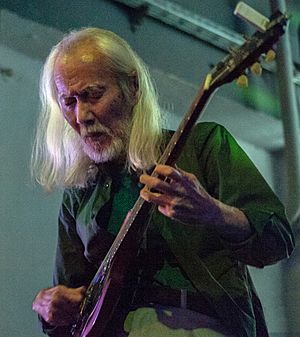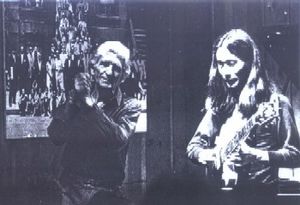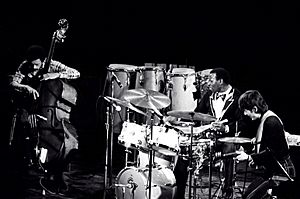Ryo Kawasaki facts for kids
Quick facts for kids
Ryo Kawasaki
|
|
|---|---|

Ryo Kawasaki performing at The Garden Brewery, Zagreb Croatia Dec 15, 2018
|
|
| Background information | |
| Native name |
川崎 燎
|
| Born | February 25, 1947 Kōenji, Tokyo, Japan |
| Died | April 13, 2020 (aged 73) Tallinn, Estonia |
| Genres | Jazz fusion |
| Occupation(s) |
|
| Instruments |
|
| Years active | 1967–2020 |
Ryo Kawasaki (川崎 燎, Kawasaki Ryō, February 25, 1947 – April 13, 2020) was a talented Japanese musician. He played the guitar, wrote music, and led bands. He was famous for helping to create and popularize a music style called jazz fusion. He also helped develop the guitar synthesizer, working with companies like Roland Corporation and Korg.
His album Ryo Kawasaki and the Golden Dragon Live was one of the first music recordings made completely using digital technology. He even created a music program called the Kawasaki Synthesizer for the Commodore 64 computer. In the 1960s, he played with many jazz groups in Japan and started his own bands.
In the early 1970s, he moved to New York City. There, he worked with famous musicians like Gil Evans and Elvin Jones. In the mid-1980s, Ryo focused on creating music software for computers. He also made dance music and started his own record company, Satellites Records. Later, in 1991, he returned to playing jazz fusion.
Contents
Ryo Kawasaki's Life Story
Growing Up in Japan (1947–1968)
Ryo Kawasaki was born on February 25, 1947, in Kōenji, Tokyo, Japan. This was a time when Japan was still recovering from World War II. His father, Torao Kawasaki, was a diplomat who worked for the Japanese government.
His father worked in many places, including San Francisco, Honolulu, and cities in China. Ryo's mother, Hiroko, spoke several languages, including German, Russian, and English. Ryo was their only child.
Ryo's mother encouraged him to learn music. He took piano and ballet lessons, and started violin at age five. He could read music even before he started elementary school. As a student, he loved astronomy and electronics. He built his own radios, TVs, and telescopes.
When Ryo was 10, he bought a ukulele. At 14, he got his first acoustic guitar. The album Midnight Blue by Kenny Burrell and Stanley Turrentine made him want to study jazz music.
In high school, he spent time at coffee-houses that had live music. He formed his own jazz band and even built an electronic organ. By age 16, his band was playing professionally in clubs.
Even though he played music regularly, he studied physics at Nippon University and earned a science degree. He also taught and judged contests at the Yamaha Corporation jazz school. He worked as a sound engineer for Japanese Victor Records, learning about mixing and editing music.
Starting His Music Career in Japan (1969–1973)
Ryo recorded his first solo album for Polydor Records when he was 22. He kept performing with his jazz group. At a young age, he was voted the third-best jazz guitarist in a Japanese jazz poll.
For the next three years, Kawasaki worked as a studio musician. He played on many different recordings, from commercials to pop songs. He also appeared on radio and TV shows. He recorded his second album for Toshiba when he was 24. He played with B.B. King at a blues festival and met George Benson. They jammed together for five hours.
He also worked with other famous Japanese jazz musicians. These included drummer Takeshi Inomata and saxophonists Jiro Inagaki and Hidehiko Matsumoto.
Moving to New York City (1973–2002)
Playing Guitar in New York (1973–1979)


In 1973, Kawasaki arrived in New York. A friend immediately got him a gig playing at the Lincoln Center for the Newport Jazz Festival. Soon, Kawasaki was playing regularly in the jazz "loft scene." He was invited to play with Bobbi Humphrey.
A few months later, Gil Evans waited for Kawasaki at his apartment door. Evans invited Kawasaki to join The Gil Evans Orchestra. They were working on a jazz recording of Jimi Hendrix songs. Hendrix had planned this project with Evans, but he died before it started.
Kawasaki also played on another Gil Evans album called There Comes a Time for RCA Records. He rehearsed with Tony Williams' Lifetime band, but Tony left for Europe before they could perform.
Kawasaki became the guitarist for the Chico Hamilton Band. He toured the U.S. and worked on film music in Hollywood. Kawasaki released his first U.S. album, Juice, in 1976 for RCA. He was one of the first Japanese jazz artists to sign with a major American label.
He then released two more albums, Prism and Eight Mile Road, for the Japanese label East Wind. He also joined the Elvin Jones Band for a year-long tour of North and South America and Europe. By 1978, Kawasaki wanted to focus on his own music.
He explored Music of India, learning ragas. He recorded an album called Ring Toss that mixed Eastern and Western music. With Dave Liebman, he recorded Nature's Revenge for the German MPS label. They toured Europe together.
Ryo also toured European jazz festivals with Joanne Brackeen as a piano-guitar duo. They recorded two albums, AFT and Trinkets and Things, for Timeless Records. In Japan, Sony's Open Sky label signed Ryo for three albums: Mirror of my Mind, Little Tree, and Live. The Live album was one of the first recordings made completely with digital technology.
Many famous musicians played on these albums, including Michael Brecker, Harvey Mason, and Anthony Jackson. He also recorded an album called Sapporo in 1980 while touring Switzerland and Germany.
Innovating as an Inventor and Programmer (1979–1990)
Kawasaki created his own guitar synthesizer in 1979. He used it for many solo shows at planetariums from 1980 to 1983. He also formed a jazz-rock group called The Golden Dragon and performed concerts in the early 1980s.
Fostex developed an eight-track recorder and asked Kawasaki to be the first artist to use it. He recorded the album Ryo in 1981 for Philips Records. He became known for creating all the music himself. He played only a nylon-string acoustic guitar. All his backing music was made with his guitar synthesizer. This included the full orchestration of Joaquín Rodrigo's famous Concierto de Aranjuez. He made a similar recording, Lucky Lady, the next year.
When the Commodore 64 computer came out, it was the first computer with a built-in music synthesizer chip. Kawasaki was very interested in its possibilities. He learned to write computer programs. For two years, he spent 16 hours a day creating four music software programs. These were Kawasaki Synthesizer, Kawasaki Rhythm Rocker, Kawasaki Magical Musicquill, and Kawasaki MIDI Workstation.
The first three programs were for schools and homes, and the last one was for professional music studios. He created an all-synthesized album, Images, in 1987. He also made the soundtrack, Pleasure Garden, in 1990, for an IMAX film about protecting Earth's rainforests.
From 1986 to 1990, Kawasaki produced many popular 12-inch dance singles. These included "Electric World" and "Say Baby I Love You." They mixed free-style, house, acid house, and ambient sounds. All the music was made in his home studio, The Satellite Station. The records were released on his own label, Satellites Records. His band and a dance group performed in New York dance clubs.
For five years, from 1988 to 1993, Kawasaki was the New York producer and director for two Japanese national weekly music radio shows. He also worked with Japanese koto master Kicho Takano to produce "Crystallization" in 1986.
Returning to Jazz Guitar (1991–2000)
Kawasaki's music changed direction again when he signed with the new Japanese jazz label One Voice. He joined as both an artist and a record producer. Kawasaki's return to jazz was his 1992 acoustic solo guitar album Here, There and Everywhere.
Kawasaki produced and performed on three albums by Brazilian singer and guitarist Camila Benson for this label. Ryo continued to release many albums. These included the acoustic My Reverie (with music from Bill Evans and Debussy) and the electric jazz guitar album Love Within The Universe.
His 1999 album Cosmic Rhythm featured British singer Clare Foster. It also included Kawasaki's rhythm section with Victor Jones on drums and Lincoln Goines on bass. David Kikoski played piano and Shunzo Ohno played flugelhorn. Kawasaki arranged and recorded all ten original songs on the album.
Between 1995 and 1999, three hip hop artists, Sean Combs, Kool G Rap, and Keith Murray, recorded Kawasaki's song "Bamboo Child" on their albums. This was more than twenty years after he first recorded it.
Life in Estonia and Beyond (2000–2020)
In 2001, Kawasaki released the live studio album Reval. It was recorded in Tallinn, Estonia, with Estonian musicians Toivo Unt on bass and Aivar Vassiljev on drums.
He also worked as a composer, music director, and guitarist for the jazz ballet "Still Point." This ballet was performed at the Estonian National Opera House from 2000 to 2002. The ballet was choreographed by Russell Adamson.
Kawasaki released his third acoustic guitar solo album E in 2002.
From 2000 onwards, Kawasaki performed more often in Russia and at Baltic region jazz festivals. His quartet played at the Rigas Ritmi Jazz Festival in Riga/Latvia, and other jazz festivals in Finland, Ukraine, and Lithuania. He also appeared many times at the Nõmme Jazz Festival in Estonia.
From 2005 to 2008, Kawasaki worked on a guitar trio project called "Art of Trio." He played with American drummer Brian Melvin and Estonian bassist Toivo Unt. They performed in Finland, Sweden, and the Baltic states. He also performed with Estonian singer Jaanika Ventsel.
He toured and recorded in Japan for a duo project with bassist Yoshio 'Chin' Suzuki. Their duo CD "Agana" was released in February 2007.
In 2008, Kawasaki formed a jazz group with Estonian pianist Tõnu Naissoo. His second duo CD with Yoshio 'Chin' Suzuki and his first CD with "Art of Trio" were released in 2009. Also, his song "Raisins" was included on the Grand Theft Auto IV radio station Fusion FM in 2008.
From 2009 to 2011, Kawasaki performed more in Lebanon. He played with Syrian bassist Omar Harb and Lebanese drummer Fouad Afra. The album Live in Beirut, recorded with Lebanese organist Arthur Satyan and drummer Fouad Afra, was released in 2011.
Starting in 2007, Kawasaki slowly developed his fourth acoustic guitar solo album Spain in Tallinn, Estonia. It was finally released in 2012.
In 2014, Kawasaki found a younger group of Estonian musicians. They inspired him to create a new fusion, jazz-rock sound using his own songs. In spring 2016, Kawasaki formed a new quartet called Level 8. It included Estonian musicians Raun Juurikas (keyboards), Kaarel Liiv (electric bass), and Eno Kollom (drums).
Level 8 recorded a self-titled album with Kawasaki's old and new songs. It had a funk/fusion/jazz-rock sound. The album Level 8 was released in March 2017.
In April 2016, the UK label Nunorthernsoul released a vinyl EP called Selected Works 1979 to 1983 by Ryo Kawasaki. A second vinyl EP, Selected Works Part 2 - 1976 to 1980 by Ryo Kawasaki, was released in April 2017.
Ryo Kawasaki passed away in Tallinn, Estonia, in April 2020. He was 73 years old.
Ryo Kawasaki's Music Albums
As a Band Leader
- Prism (East Wind, 1976)
- Juice (RCA, 1976)
- Ring Toss (Chiaroscuro, 1977)
- Eight Mile Road (East Wind, 1978)
- Nature's Revenge (MPS, 1978)
- Mirror of My Mind (Satellites, 1979)
- Little Tree (1980)
- Live (Openskye, 1980)
- Featuring Concierto De Aranjuez (Philips, 1982)
- Lucky Lady (Continental, 1983)
- Images (Ryka, 1987)
- My Reverie (Videoarts, 1993)
- Remixes Remixes Vol. 1 (One Voice/Satellites, 1994)
- Love within the Universe (Videoarts, 1994)
- Plays Solo Guitar Here There and Everywhere (Videoarts, 1995)
- Sweet Life (Videoarts, 1996)
- Cosmic Rhythm (One Voice, 1999)
- Agana with Yoshio Chin Suzuki (DIW, 2007)
- Late Night Willie with Yoshio Chin Suzuki (Studio Songs 2009)
- Live in Beirut 2011 (Studio Songs, 2011)
- Plays Solo Guitar: Spain (Studio Songs, 2012)
- Level 8 (Vivid Sound, 2017)
- Giant Steps (Studio Songs, 2019)
- Level 8 Live (Studio Songs, 2019)
As a Sideman (Playing with Others)
- Joanne Brackeen, Trinkets and Things (Timeless, 1978)
- Joanne Brackeen, AFT (Timeless, 1978)
- John Clark, I Will (Postcards, 1997)
- Ted Curson, I Heard Mingus (Trio 1980)
- Gil Evans, The Gil Evans Orchestra Plays the Music of Jimi Hendrix (RCA, Victor 1974)
- Gil Evans, There Comes a Time (RCA, 1976)
- Clint Houston, Inside the Plain of the Elliptic (Timeless, 1979)
- Takeshi Inomata, Sounds of Sound L.T.D. (Columbia, 1970)
- Elvin Jones, The Main Force (Vanguard, 1976)
- Elvin Jones, Time Capsule (Vanguard, 1977)
- Teo Macero, Impressions of Charles Mingus (Palo Alto 1983)
- Teo Macero, Fusion (Europa, 1984)
- Teo Macero, Acoustical Suspension (Doctor Jazz 1985)
- Steve Marcus & Jiro Inagaki, Something (Columbia, 1971)
- Sam Morrison, Dune (East Wind, 1977)
- Shigeharu Mukai, Pleasure (Better Days 1980)
- Minoru Muraoka, Osorezan Suite (Yupiteru, 1978)
- Masahiko Satoh, All-in All-Out (Openskye, 1979)
- Masahiko Satoh, Bridge Over Troubled Water (Columbia, 2007)
- Cedar Walton, Mobius (RCA, 1975)
- Joe Lee Wilson, What Would It Be Without You (Survival, 1976)
Software Created by Ryo
- Kawasaki Synthesizer (1984)
- Kawasaki Rhythm Rocker (1984)
- Kawasaki Magical Musicquill (1985)
- Kawasaki Midi Workstation (1986)
Videos and Films Featuring Ryo
- Different Drummer with Elvin Jones (1979)
- Jazz in Exile Documentary (1982)
See also
 In Spanish: Ryō Kawasaki para niños
In Spanish: Ryō Kawasaki para niños

